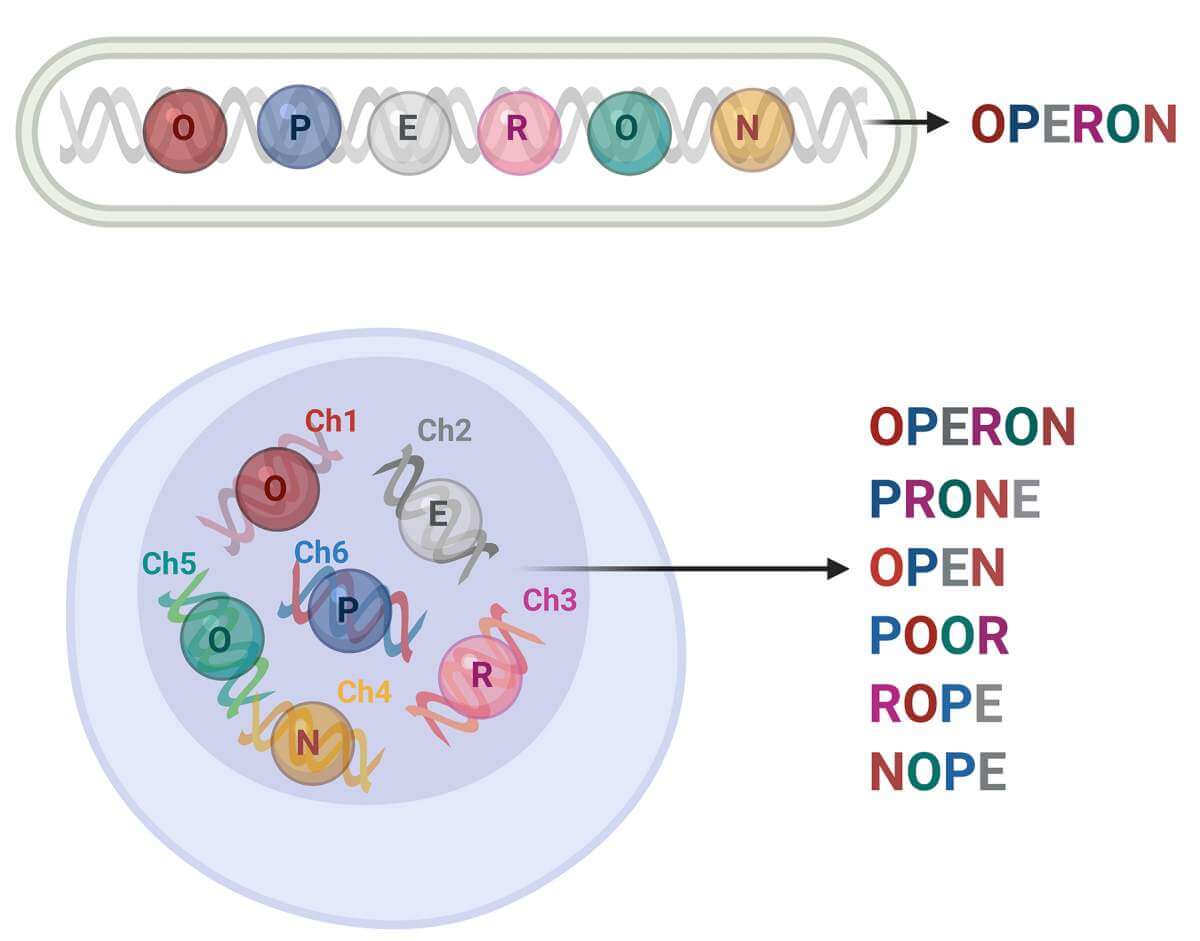How did evolution overcome the lack of order in the storage of genetic information in the transition from bacteria to more developed creatures?

"Every discovery about E. coli is necessarily valid for elephants as well," Jacques Monaud, the French biologist who won the Nobel Prize in 1965, who discovered a genetic control system in E. coli bacteria, was quoted as saying. Assuming Mono was right, how is it possible that the genetic information in bacteria is organized so differently than in elephants, peacocks or humans?
The method of organizing the genetic information in bacteria is known as "beads on a string": genes that participate in the same biological-cellular process are organized one after the other along the DNA strand - similar to a rosary - and form a single functional unit that has been named an "operon". When needed, these genes are transcribed together and form one long messenger RNA molecule. "The method used in bacteria to organize genetic information is an excellent way to ensure expression of the right genes at the right time," explains Prof. Geoffrey Gerst From the Department of Molecular Genetics at the Weizmann Institute of Science the operon advantage.

However, unlike bacteria, which are prokaryotic creatures, meaning they lack a cell nucleus and differentiated organelles, eukaryotic organisms - from yeast to humans - store their genetic information in the cell nucleus. Unlike the well-ordered bacterial operons, in the cell nucleus the genes are scattered over different chromosomes, sometimes without visible order or logic. How, then, are genes required for the same cellular process, but found on different chromosomes, expressed? "Compared to the relatively simple bacterial arrangement, the form of genetic organization in eukaryotes is somewhat chaotic. Therefore, a mechanistic explanation must be found that allowed these life forms to develop and thrive despite the so-called mess," adds Prof. Gerst.
In order to locate this mechanism, Prof. Gerst and a research team led by the postdoctoral researcher Dr. Rohini Nair and the research student at the time, Dr. Dmitri Zabrzynski, used baking yeast - a single-celled eukaryote that has been used by humans for many years - no Only in the preparation of comforting pastries and intoxicating drinks, but also as a model for the study of evolutionarily conserved cellular processes. The research team used a method previously developed in Prof. Gerst's laboratory to capture RNA molecules through the precipitation of proteins that bind to these molecules as they leave the cell nucleus. so The researchers were able to locate for the first time Bundles of RNA molecules, each originating from a different chromosome, but they were intended to be translated into proteins participating in the same biological process. "We called these bundles 'transperons' - RNA molecules that originate from different chromosomes, but function as a sort of single functional unit, similar to the bacterial operon," explains Prof. Gerst.

In order to put the transferron hypothesis to the test, Dr. Nair exposed the yeast cells to abnormal heat conditions in order to induce a "heat stroke response" in them - a universal cellular process involving several different proteins. The findings were consistent with the hypothesis: the messenger RNA molecules that carry the instructions to create the heat shock proteins, clustered together to create transferron.
Moreover, the researchers discovered that in order to produce the bundle of RNA required to deal with heat, the yeast cells changed their DNA structure so that the relevant genes located on different chromosomes would be physically close to each other. In this way, the researchers hypothesize, eukaryotic cells make sure that the genes involved in a certain process will be silenced more or less at the same time and will find themselves in the same RNA bundle. "When we disrupted the action of the proteins that help group the RNA molecules together, they became detached from the bundle and the cellular process for which they were intended was damaged," adds Prof. Gerst.
These findings point to the possibility that eukaryotic cells developed during evolution a kind of genetic "stroke-na" game: they use the same "letters" - that is, messenger RNA molecules originating from genes located on different chromosomes - to create different "words", i.e. different transferrons. In this way, the eukaryotic organisms could expand their functional repertoire and develop into complex life forms - from fungi to humans - and at the same time maintain a certain degree of control over these processes, similar to their ancient bacterial ancestors.
If so, Mono's assertion about elephants and bacteria was perhaps a bit exaggerated, but now it seems that elephants, like other evolved creatures, do have a counterpart to the bacterial operon mechanism.
More of the topic in Hayadan:
